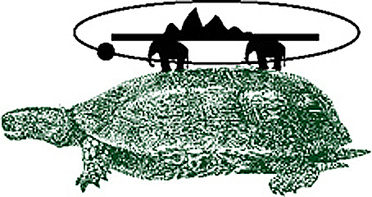ORBITAL MECHANICS: THE MASS OF THE TURTLE
|
The Discworld sun orbits in a fixed ellipse, period one day, in a plane at right angles to the Disc. The Disc revolves beneath it, with a period of 800 days. Each spin year has eight seasons (two of each) but the inhabitants work in half-years of 400 days. There are 13 months, and each week has 8 days.
The diameter of the Disc (Expletius) is 10,000 miles. The sun is small, and its distance from the Disc is about 70 miles (so occasionally an elephant has to lift a leg to let it pass underneath). |
From these data and some Roundworld maths we can deduce the total mass of the Disc (including elephants and turtle) using the Law of Gravity.
By Kepler’s Third Law of Planetary Motion, the square of the period of one body orbiting another is proportional to the cube of its average distance.
P^2 ~ a^3
According to Isaac Newton, the constant of proportionality is the sum of the masses M+m of the two bodies, so
(M+m)P^2 = a^3
where M is the mass of Discworld + turtle + elephants and m is the mass of its sun.
Using units:
P : years
a : astronomical units
M, m : Roundworld-solar masses
then for Roundworld we have
M = Msun = 1
m = mroundworld << 1 hence negligible
a = 1
P = 1
so we get
(1 + m)1^2 = 1^3
which is true since mroundworld is negligible compared to Msun. This means we are using the right units, which is a relief...
Similarly for Discworld we have
M = MD+T+E where D = Disc, T = Great A’Tuin, and E = elephants
m = mDWsun ~ 0 since negligible
a = 70/93000000 Astronomical units, OK?
P = 1/365 DW day ~ RW day and we’re using years
so we get
(M + 0)(1/365)^2 = (70/93000000)^3
so that
M = 5.681x10^(-14) solar masses
where
1 solar mass = 2 x 10^(30) kilogrammes
Now m is negligible compared with M. So
M = 4 x 10^(16) kilogrammes
Which is SIX times the mass of Roundworld.ℵ
Most of this mass is turtle because:
• The Disc is 30 miles thick at the rim and although it gets bigger in the middle its total volume is much smaller than Roundworld’s (as measured from the inside).
• Chelonium is known to be far denser than elephantigen.
Therefore, to a fair approximation, the mass of the turtle is SIX times the mass of Roundworld≠€.
ℵ No it’s not. It is if you divide by 10^7. You missed the deliberate mistake in the lecture, didn’t you?
≠ Divided by ten million as stated earlier.
€ The centre of mass of the turtle (+ elephants + Disc) lies at the focus of the ellipse. Curiously, this implies that the turtle’s centre of mass lies outside the turtle. Both mathematicians and authors prefer to slide over this point. Chemists take consolation in the fact that chelonium is funny stuff and cannot be expected to obey the usual rules.
By Kepler’s Third Law of Planetary Motion, the square of the period of one body orbiting another is proportional to the cube of its average distance.
P^2 ~ a^3
According to Isaac Newton, the constant of proportionality is the sum of the masses M+m of the two bodies, so
(M+m)P^2 = a^3
where M is the mass of Discworld + turtle + elephants and m is the mass of its sun.
Using units:
P : years
a : astronomical units
M, m : Roundworld-solar masses
then for Roundworld we have
M = Msun = 1
m = mroundworld << 1 hence negligible
a = 1
P = 1
so we get
(1 + m)1^2 = 1^3
which is true since mroundworld is negligible compared to Msun. This means we are using the right units, which is a relief...
Similarly for Discworld we have
M = MD+T+E where D = Disc, T = Great A’Tuin, and E = elephants
m = mDWsun ~ 0 since negligible
a = 70/93000000 Astronomical units, OK?
P = 1/365 DW day ~ RW day and we’re using years
so we get
(M + 0)(1/365)^2 = (70/93000000)^3
so that
M = 5.681x10^(-14) solar masses
where
1 solar mass = 2 x 10^(30) kilogrammes
Now m is negligible compared with M. So
M = 4 x 10^(16) kilogrammes
Which is SIX times the mass of Roundworld.ℵ
Most of this mass is turtle because:
• The Disc is 30 miles thick at the rim and although it gets bigger in the middle its total volume is much smaller than Roundworld’s (as measured from the inside).
• Chelonium is known to be far denser than elephantigen.
Therefore, to a fair approximation, the mass of the turtle is SIX times the mass of Roundworld≠€.
ℵ No it’s not. It is if you divide by 10^7. You missed the deliberate mistake in the lecture, didn’t you?
≠ Divided by ten million as stated earlier.
€ The centre of mass of the turtle (+ elephants + Disc) lies at the focus of the ellipse. Curiously, this implies that the turtle’s centre of mass lies outside the turtle. Both mathematicians and authors prefer to slide over this point. Chemists take consolation in the fact that chelonium is funny stuff and cannot be expected to obey the usual rules.

